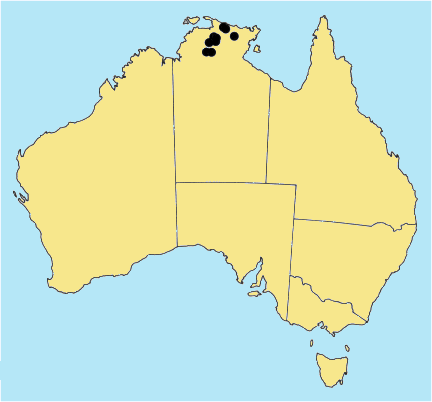Eriachne compacta M. Lazarides. Austral. Syst. Bot. 8: 377 (1995).
Classification. (GPWG 2001) : Subfamily Micrairoideae. Eriachneae.
Type of Basionym or
Protologue Information: Australia: Northern Territory: Darwin and Gulf
District: Kakadu National Park, 12.17S 132.52E, 23 May 1980, M. Lazarides
8938 (HT: CANB; IT: BRI, DNA, K, L, MO, PE, PRE, US).
Key references
(books and floras): [2002] D.Sharp & B.K.Simon, AusGrass, Grasses of
Australia.
Illustrations:
[2005] K.Mallet (ed.), Flora of Australia 44B: Poaceae 3 (Fig.
27G).
Habit. Annual.
Culms erect or geniculately ascending, stature slender to delicate, 5–40 cm
tall, 4–6 -noded. Mid-culm nodes glabrous. Lateral branches branched or
fastigiate. Leaf-sheaths smooth, glabrous on surface. Ligule a fringe of hairs,
0.2–0.3 mm long. Leaf-blades flat or convolute, 2.5–4 cm long, 2–3 mm wide.
Leaf-blade surface scabrous, glabrous or indumented.
Inflorescence.
Inflorescence compound, a panicle. Panicle ovate, 0.5–2.5 cm long, 0.5–1 cm
wide.
Spikelets.
Spikelets pedicelled. Fertile spikelets 2-flowered, both fertile, comprising 2
fertile floret(s), without rachilla extension, ovate, laterally compressed, 5–6
mm long.
Glumes.
Glumes similar, thinner than fertile lemma. Lower glume ovate, membranous, much
thinner on margins, without keels, 9–11 -nerved. Lower glume surface glabrous.
Lower glume apex muticous or mucronate. Upper glume ovate, 5–6 mm long,
membranous, without keels, 9–11 -nerved. Upper glume surface smooth or
asperulous or scabrous, glabrous. Upper glume apex muticous or mucronate.
Florets.
Fertile lemma 4–4.5 mm long, without keel, 7 -nerved. Lemma surface indumented.
Lemma apex awned, 1 -awned. Median (principal) awn 3–4 mm long overall. Palea 2
-nerved. Palea apex entire or dentate, muticous. Anthers 3. Grain 1.2–1.6 mm
long.
Continental
Distribution: Australasia.
Australian
Distribution: Northern Territory.
Northern Territory:
Darwin & Gulf.
Notes.
Distinguished by thin often ribbed and subterete culms with glabrous nodes,
loose relatively short leaf sheaths much wider than blades, compact short
prominently exserted often ovate panicles, glabrous inflated sometimes
orbicular glumes with broad nerveless margins, florets unequal and shorter than
glumes, bearded obtuse callus, appressed lemma and palea, grooveless shortly
awned membranous lemma with hyaline margins and ciliate or scabrous submargins,
ciliate palea keels, and terminally exserted anthers. E. compacta is
readily distinguished from all other species in the genus and appears to be
isolated in its relationships.
Endemic.
N.T. N of 15ºS. Damp or seasonally wet sites near streams, rock pools and in
seepage zones, in often shallow, sand or silt, in association with sandstone
plateaux, outcrops and escarpments, and sometimes in rock cracks of sandstone
outcrops. Flowers and fruits Mar.-June (autumn to early-winter).




